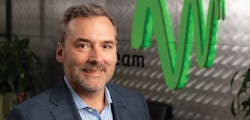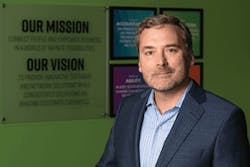Watch ISE EXPO 2019 Keynote Presented by Tony Thomas, President & CEO, Windstream
Watch Tony Thomas’s Keynote Address to ISE EXPO 2019 here
Executive Insights Q&A With ISE EXPO 2019 Keynote Presenter, Tony Thomas, President & CEO, Windstream
Topic: PRIORITIES —
What are your top network-related priorities for the rest of 2019?
Tony Thomas, Windstream: Windstream is comprised of 3 business units. Kinetic by Windstream serves residential broadband and SMB customers in 18 states. Windstream Enterprise provides data, UCaaS and security solutions to businesses and government agencies nationwide. Windstream Wholesale provides connectivity for cloud and data center operators, wireless carriers and international carriers across the US and Canada.
Our network priorities vary by business unit, but there are common threads. First, we are increasing speed availability through fiber and fixed wireless network expansion, and improving our reach through network builds and swaps. Second, we are using software to improve network resiliency, performance, and visibility. We are the nation’s largest SD-WAN service provider, and our priorities include expanding our product set and continued focus on differentiated features centered around both the technology and the digital experience.
Topic: OVERLOOKED ISSUES
What should all of us in the Information and Communication Technology (ICT) industry be talking about that we are not? Or, what current topic is the most important that needs additional and different attention?
Thomas: The digital transformation is in every buzzword bingo game today, and that is rightly deserved. Digital software development is now a core component of a great network solution. Every network company is now 2 companies in 1: a construction company and a software company. You must be great at both: building networks and providing software solutions that make the network solution more valuable.
Another topic that is not getting much attention is the consolidation of network assets into just a few national players and the lack of a healthy wholesale ecosystem. Wireless offers a preview into the wired network marketplace. The inability of wireless carriers to have functionality to operate outside their territory through wholesale arrangements resulted in the de facto nationalization of the marketplace.
What is your greatest pain point delivering higher speeds to underserved and rural communities? What are some solutions?
Thomas: I am incredibly passionate about the subject of broadband in rural America. My roots are in rural Central Illinois, and Windstream serves many rural communities in 18 ILEC states. The biggest challenge to broadband in rural America is principally around the cost of deployment and the expected financial returns. At a high level, the economics of broadband are tied to population density: the fewer people in a geographic area, the more it costs to serve them.
The solution is a private-public partnership that combines the investment of both to make the economics of rural broadband feasible. I also believe fixed wireless technologies are going to be another part of the solution.
Another key part of this solution sounds so simple but is far from it: knowing who is unserved and underserved in the US. The broadband availability maps are woefully deficient and need to be improved. Windstream is working with USTelecom and other industry partners on a mapping project that would identify every broadband serviceable location in 2 states. At some point, we hope the FCC will roll this out on a nationwide basis so we can make smart decisions on how our nation will spend tens of billions of dollars to close the digital divide.
InvisiLight® Solution for Deploying Fiber
April 2, 2022Go to Market Faster. Speed up Network Deployment
April 2, 2022Episode 10: Fiber Optic Closure Specs Explained…
April 1, 2022Food for Thought from Our 2022 ICT Visionaries
April 1, 2022Topic: Upgrade Realities and ROI
Upgrading a network is no small feat, nor is it inexpensive. Thus, all network upgrades must be thoroughly vetted to ensure that they both provide the necessary performance enhancements while also making themselves financially viable. It’s a tricky balancing act.
What network upgrades are most important to Windstream?
Thomas: Indeed, this is a tricky balancing act. Windstream is focused on finding that balance on network upgrades, and our most important upgrade effort today is around our 5G fixed wireless efforts to provide 1 Gig broadband speeds. The potential for game-changing economics with fixed wireless has our full attention. We also continue to vet new fiber deployment methods, including for both buried and aerial fiber deployments. The most important breakthrough here has been the ability to model various network designs across our 4 million residential locations and 300,000 commercial locations in days instead of years. Our software modeling capabilities that we built a few years ago ensures we make every dollar count.
Topic: WEARABLES IMPACT
5G Americas forecasts that by 2021 there will be an estimated 929 million wearable devices globally, growing nearly threefold from 325 million in 2016 at a CAGR of 23%. Only 7% will have embedded cellular connectivity by 2021, up from 3% in 2016. Global shipments of wearables are due to increase at a 24.8% CAGR over the next 5 years, reaching 162.9 million units in 2020. All the data shows mobile consumption increasing, yet US operators are struggling to monetize that trend in an intensely competitive market.
How can this impact providers topline revenue and also prevent churn by their current customers?
Thomas: This is not the answer many want to hear: there is little ability for the wireless carriers to monetize their 5G investments. Today, and likely tomorrow, the value will accrete to the mobile applications associated with the wearable devices. If you want to monetize the trend in wearables, you need to be more than just another pipe.
Topic: THE FUTURE
What emerging or disruptive technology excites you the most for the future of the ICT industry? What keeps you up at night about those things?
Thomas: I do believe machine learning is probably the biggest, most disruptive technology that I am most excited about. Windstream is using machine learning to optimize customer SD-WAN application prioritization. It is an incredibly powerful tool that is being powered by, of all things, open source software. Open source software has a very attractive licensing model. It is a brave new world.
What keeps me up at night? The next big thing! I freely admit I do not know what that might be, but did anyone see SD-WAN decapitating MPLS? The ability of technologies like SD-WAN to dramatically improve both economics and performance relative to MPLS is shocking. These type of rapid technology cycles are likely the new norm.
Topic: YOU!
What has been your greatest accomplishment as CEO of Windstream? What has been your biggest disappointment?
Thomas: My greatest accomplishment as CEO is to organize the company around small teams that are empowered and accountable for results. The power of the small teams to drive the business forward no longer surprises me. It is the new normal.
My biggest disappointment has been in the industry to watch the collapse of the wired wholesale marketplace. I saw it unravel when I was in the wireless industry at Alltel, and I have seen it unravel again in the wireline industry when I was an active participant in it. Our policy makers must recognize without a wholesale market, we are destined to have either national — and only — national communication providers or small, ultra-local providers. I am uncertain how that propels us forward as an industry or, more importantly, as a country.
Topic: MENTORING
What hands-on things should good mentors do?
Thomas: Be available! It begins with just making the time to invest in others. And, be a purposeful listener and a powerful truth-teller. Truth-telling can be very hard, and it can only be done in a relationship built on trust.
Topic: BEST FOR VETS
Windstream was named to be the best employer in 2019 for veterans by MilitaryTimes. This is the third consecutive year that Windstream has made the list.
What does your team do differently than others that makes Windstream a great place to work for our veterans?
Thomas: It sounds simple but we target veterans for positions within Windstream, hire them for those positions, and equip them for success through training. This is a classic win-win scenario. Windstream recently needed to hire over 400 field technicians across the US in 18 months, and we knew that was going to be a difficult task. The task was made a lot easier when we focused on hiring veterans to fill many of those roles. In addition, I would be remiss not to mention the Windstream talent acquisition team is laser-focused about hiring veterans, and has amassed an incredible track record.
Topic: BEING ALL THINGS TO ALL USERS
A significant challenge for service providers today is the need to simultaneously service consumers and industry verticals, including transportation, high value manufacturing, healthcare, agriculture, smart cities, etc. The range of options puts pressure on networks to be all things to all users.
What is your advice to telecom providers about this challenge?
Thomas: My advice is to not be all things to all users. Pick areas where you can be different in the marketplace.
Topic: AGILITY
A business needs to run 2 models simultaneously: one optimized for today, and one optimized for tomorrow.
How do you do that well without neglecting one or the other?
Thomas: Most of our teams are focused on taking care of customers every day and optimizing those experiences. They do amazing work for our customers! We also have teams that invest time and energy in innovation. Innovation takes constant nurturing to ensure new ideas come forward and are protected inside of large organizations. We work to ensure teams focused on big innovative ideas have a lot of room to operate independently of the rest of the business.
Topic: YOUR ROLE
What is the most interesting thing about your role? What would you recommend to someone who wants to achieve a high-level position in their career?
Thomas: The most interesting thing about my role is the discussions with customers around their business challenges and opportunities. These interactions provide a unique vantage point across many industries, and I find myself often surprised by the commonalities in these varied industries. My advice for career growth is to run to the challenges and opportunities, and be willing to change positions freely to gain more experiences. A 360-degree view of the business makes leaders more well-rounded and understanding of the impact of changes on the business.
Topic: BALANCE
What do you do to help create work/life balance in your life?
Thomas: I am a big believer in being purposeful with time, our scarcest of resources. We live in an ever-more connected world, and it can be difficult to find that balance as a result. Sometimes the best idea is simply to disconnect from the mobile phone and laptop. In Little Rock, where Windstream has its headquarters, we are blessed to have great city and state parks and National Forest land in proximity. It is easy to get outside and be active.
Topic: DIVERSITY
Share the changes you are most proud of related to diversity and inclusion.
Thomas: Our efforts around diversity and inclusion are powered by a group of diverse employees who are driving positive change inside the organization. Their efforts are supported by the senior leaders in the company, but the real force for change and ideas is coming from our people. We have a more diverse and inclusive workforce today than ever before due to their efforts.
Topic: SATISFACTION
Please fill in the blank. Satisfaction is ________________.
Thomas: Satisfaction is winning a new customer relationship. It is very rewarding to see our network and software solutions put to use to make customers’ lives more fulfilling or their businesses more successful. The pride and care the Windstream team will take to nurture that into a long-term relationship is awesome to watch.
Like this Article?
Subscribe to ISE magazine and start receiving your FREE monthly copy today!
About Tony Thomas
Thomas has more than 20 years of experience in the communications industry. He was instrumental in the development of Windstream’s REIT spinoff and served as president of real estate investment trust operations at Windstream from October to December 2014.
Thomas served as the chief financial officer for Windstream from August 2009 through September 2014. During his 5-year tenure as CFO, Thomas played an integral role in Windstream’s expansion by completing 7 acquisitions totaling more than $5.6 billion in transaction value. In addition, Thomas has deep capital market expertise, having led almost $10 billion in debt transactions.
Thomas joined Windstream as controller following the spinoff from Alltel Corp. He held a variety of financial and operational leadership roles at Alltel after joining the company when it merged with 360 Communications in 1998. Before entering the communications industry, he was with Ernst & Young in the telecom practice. He holds a master’s degree in business administration from Wake Forest University and a bachelor’s degree in accountancy from the University of Illinois.
About the Author
Sharon Vollman
Content Ambassador for ISE EXPO
Sharon Vollman is the Content Ambassador for ISE EXPO. She is passionate about collaborating with thought leaders, SMEs and hard-working doers who design, plan and deploy ultra-reliable broadband networks. Vollman is committed to creating a variety of educational offerings for ISE EXPO attendees that inspire them to connect every U.S. citizen with the broadband networks we all want for our children and grandchildren.
Vollman has created educational partnerships with Broadband Service Providers including AT&T, Verizon, Lumen, Frontier Communications and others. She has covered the telecom industry since 1996.






